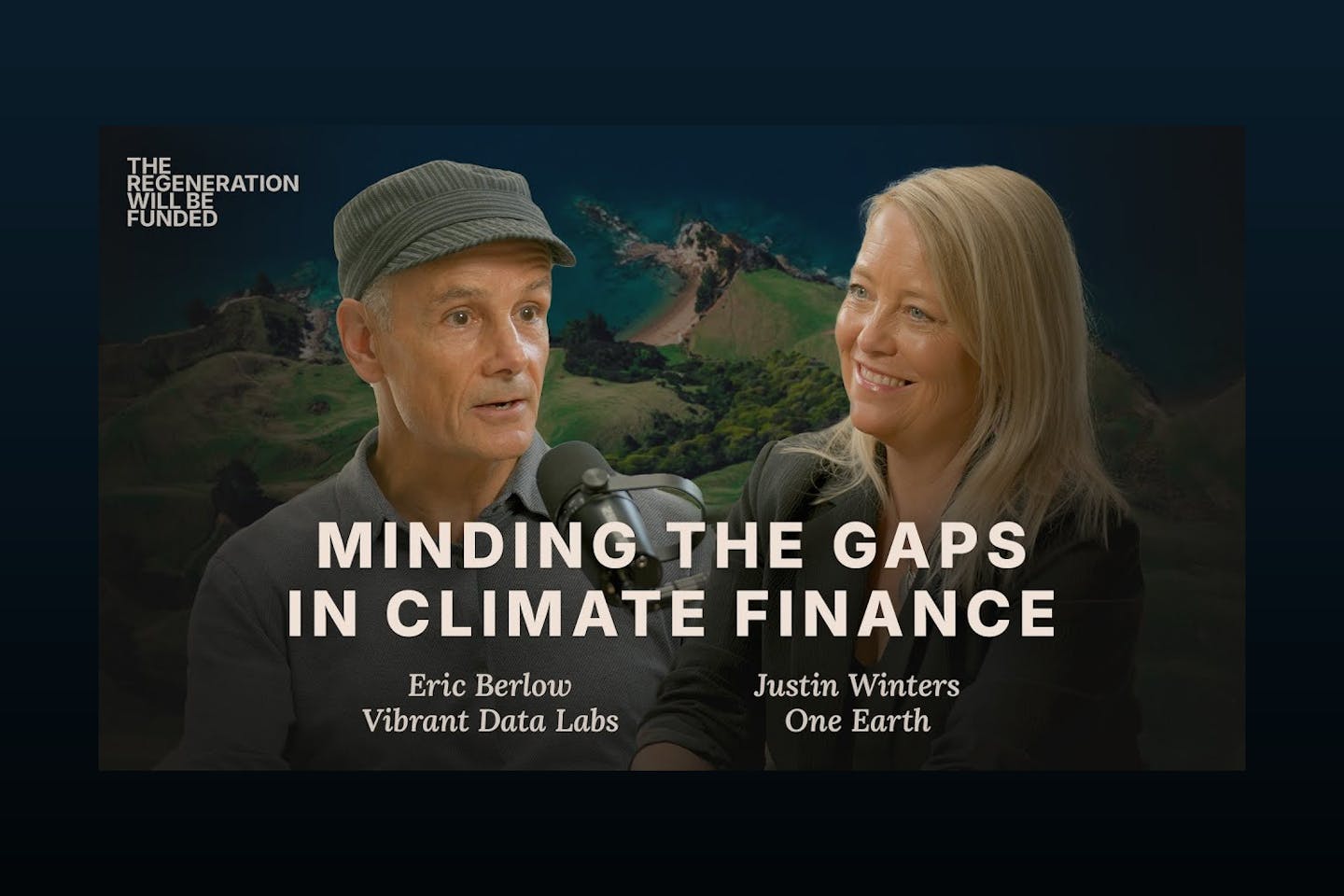Minding the Gaps: Mapping climate finance for a better future
An interview with Justin Winters, Executive Director of One Earth, and Eric Berlow, CEO of Vibrant Data Labs, in conversation with Matthew Monahan.
Transcript
One Earth has launched Minding the Gaps, a groundbreaking report and data tool developed in collaboration with Vibrant Data Labs. This first-of-its-kind Solutions Finance Tracker maps where climate and nature funding is — and isn’t — flowing, highlighting key opportunities to close the gaps in sustainable finance.
The tracker currently follows $400 billion in private, philanthropic, and government funding across 11,000 US-based organizations and 14,000 funders, creating the most comprehensive picture yet of climate-relevant finance.
A Systems approach to climate finance
Eric Berlow:
At Vibrant Data Labs, we focus on making it easier for money to flow where it needs to go from a systems perspective. Climate is inherently a systemic problem — and One Earth’s Solutions Framework provides a clear systems model for how to address it. Once you know what needs to be done, the simplest way to create large-scale change is to identify and fill the gaps in funding.
Justin Winters:
That’s why we built the Minding the Gaps tool. It’s both a report that tells the story and a live data platform that lets funders, investors, and researchers see where capital is flowing — and where it’s not. It’s an actionable roadmap for aligning money with the solutions that can actually solve the twin crises of climate change and biodiversity loss.
The One Earth Climate Model and Solutions Framework
Justin Winters:
Before leading One Earth, I directed the Leonardo DiCaprio Foundation for 13 years. During that time, we saw a lack of clarity around whether it was even possible to solve climate change and biodiversity loss together. So we began funding the science to find out.
That work led to the One Earth Climate Model, first released in 2019, which shows that we can achieve the 1.5°C goal — using existing technologies and nature-based solutions that honor Indigenous and local stewardship.
From that foundation came the One Earth Solutions Framework:
- 100% clean, renewable energy for all
- Protecting, connecting, and restoring 50% of the planet’s lands and oceans
- Transitioning food and fiber systems to regenerative agriculture
This framework breaks down into more than 75 specific solution pathways across those three pillars. It’s a comprehensive yet human-centered roadmap that shows exactly what needs to happen and who’s working on it.
Turning insight into action
Eric Berlow:
For decades, we’ve known the problem — we’ve just lacked a roadmap for what to do. One Earth’s framework changes that. When funders know where to invest, money starts to move. Since the introduction of solution frameworks like this, investment in climate solutions has outpaced the broader market.
Our goal was to bring transparency to this landscape. By tracking climate-related investments, philanthropy, and government funding at the organization level, and then rolling that up to the solution level, we can finally see which areas are overfunded, underfunded, or entirely overlooked.
What the data shows: The biggest gaps
Justin Winters:
The data reveals both exciting progress and critical shortfalls. Of all tracked finance:
- 89% goes to renewable energy,
- 7% to regenerative agriculture, and
- only 4% to nature conservation.
That’s deeply concerning, given that nature-based solutions are projected to deliver 45% of avoided emissions by 2055. We’re seeing 40% of organizations working in the nature space receiving just 4% of the funding.
Eric Berlow:
Exactly. It’s not that energy is overfunded — it’s that everything else is dramatically underfunded. We need balance. For instance, half of all renewable energy funding goes to solar photovoltaics, even though it represents only 18% of projected energy demand by mid-century. Meanwhile, renewable heat technologies, which could meet a quarter of future demand, receive just 2% of the funding.
Why Indigenous and local Leadership matters
Justin Winters:
Most of the capital supporting nature conservation is philanthropic, but less than 6% reaches Indigenous land tenure — even though roughly 40% of critical conservation areas are Indigenous lands. Our previous Global Safety Net research mapped 16,000 unprotected high-priority sites around the world. If we’re serious about protecting 50% of Earth’s ecosystems, we must direct far more funding to the communities already stewarding them.
Building the tracker: Data, AI, and transparency
Eric Berlow:
We built the system using open data sources like Crunchbase and Candid, scraping and analyzing information from thousands of companies and nonprofits. Using language models, we identify which organizations are truly climate-relevant and match them to specific solutions in the One Earth Framework.
It’s a massive data challenge, but it’s designed to evolve. Every six months, we update the dataset and refine our models, so the tool becomes smarter and more useful over time. Our aim is to make all of this open source — a public resource for everyone driving climate solutions.
The role of philanthropy
Justin Winters:
One of the most powerful insights this project reinforces is the critical role of philanthropy. While investment capital often flows to market-based solutions like clean tech, philanthropic funding is what drives innovation in nature conservation, regenerative agriculture, and community-led projects. These areas are essential to planetary stability but don’t always have immediate ROI.
We need to reframe philanthropy not as charity, but as catalytic capital — seeding the solutions that private markets will later scale.
From climate crisis to a better future
Eric Berlow:
I’ve started calling our tool the Better Future Finance Tracker — because that’s what this work is really about. Every solution we’re tracking leads to a better life: clean air, renewable energy, healthy food, thriving biodiversity. When you focus on those tangible improvements, the politics fade away.
We’ll look back and say, “Do you remember when we burned gas inside our homes to cook? When we drove hours to see nature?” The world we’re building is simply better.
The Solutions Hub
Justin Winters:
This fall, we launched the One Earth Solutions Hub, a dynamic platform that brings together the science, the solutions, and the stories — all in one inspiring place. You can explore each pathway, see who’s working on it, and discover how to get involved.
Minding the Gaps is just the beginning. The report and the tracker will continue to evolve with new data, insights, and stories that empower funders, investors, and individuals to take informed action.
Call to action
Justin Winters:
You can explore the report and interactive tool at mindingthegaps.oneearth.org. Share it. Use it to guide your funding decisions. And most importantly, remember that every contribution counts.
We can achieve a stable, thriving planet — but only if we all work together to fill the gaps.
Read the Full Report

.jpeg?auto=compress%2Cformat&h=600&w=600)
